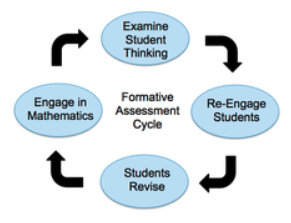Formative Assessment Link to this section
 Formative assessment describes a range of teacher actions which begin with the gathering of evidence of student thinking. This information helps teachers to adapt their teaching and meet student learning needs through targeted feedback. The evidence-gathering can be an informal, in-the-moment observation of student work and behavior, or a formal, rigorous analysis of student thinking through written work or observations of discourse. Teachers use the evidence to identify student strengths and needs, provide targeted feedback, and re-engage with challenging concepts (see Re-engagement). This feedback and shift in instruction can happen in the moment, in planning for the following day, or in planning for work in a following unit.
Formative assessment describes a range of teacher actions which begin with the gathering of evidence of student thinking. This information helps teachers to adapt their teaching and meet student learning needs through targeted feedback. The evidence-gathering can be an informal, in-the-moment observation of student work and behavior, or a formal, rigorous analysis of student thinking through written work or observations of discourse. Teachers use the evidence to identify student strengths and needs, provide targeted feedback, and re-engage with challenging concepts (see Re-engagement). This feedback and shift in instruction can happen in the moment, in planning for the following day, or in planning for work in a following unit.
Why do I use formative assessment? Link to this section
Research has consistently shown that that the use of assessment to inform instruction and give feedback increases student learning. When teachers know what their students strengths and needs are, they can tailor their teaching to build on the strengths and support the needs. They can also identify which teaching structures work and which need to be modified to better support students.
When should I use formative assessment? Link to this section
Informal formative assessment should be used daily to inform instructional decisions. More formal and deliberate formative assessment should be done at least once every unit. The tasks that form the backbone of the SFUSD Core Curriculum Units create convenient opportunities for formative assessment. They can give teachers information about how students are taking up and applying the new content, and help them plan upcoming lessons which re-engage students with the material (see Re-engagement) in the unit.
How do I use formative assessment? Link to this section
Formative Assessment has six key steps:
- Make the objectives of the lesson explicit: share the objectives with students and occasionally ask students to produce evidence that they can achieve the objectives.
- Observe and listen to groups as well as individual students.
- Watch and listen before intervening: when you do intervene, begin by asking students to explain their thinking.
- Ask open-ended questions that allow students to explain their thinking and reasoning.
- Give constructive, useful feedback that pushes students to think: make comments, oral or written, that help students recognize what they can do, what they need to be able to do, and how they might narrow the gap.
- Give students the opportunity to improve their work: students can either revise work that they have done or do a similar mathematical activity to experience and show growth.
Opportunities for formative assessment occur in every lesson. For example, students can respond on mini-whiteboards for individual assessment. Teachers can also take the opportunity to look over shoulders and listen in on student conversations, or to join student conversations with open-ended questions that allow students to explain their reasoning.
Learn more about Rubrics, which are one tool that can be used as part of the formative assessment process.
Formative Assessment Lessons (FAL): Learn more about steps involved in using FALs.
This page was last updated on October 21, 2022

